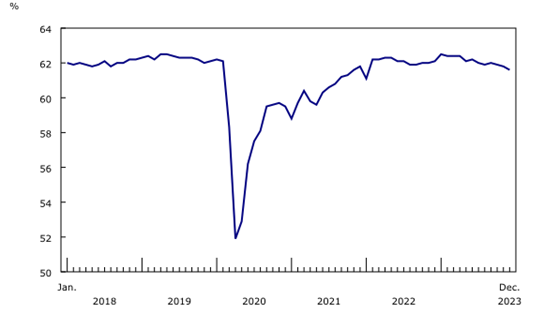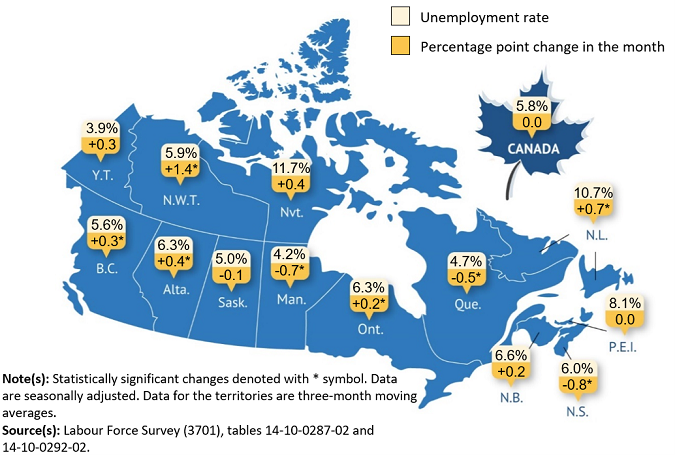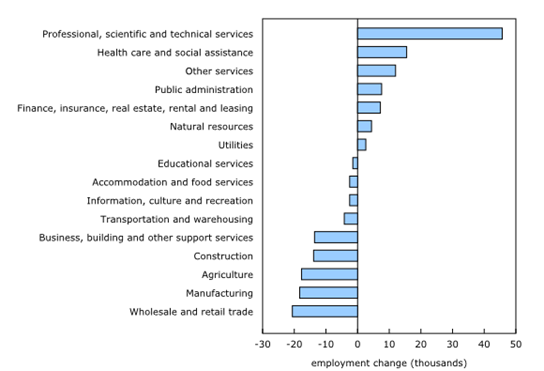Number of jobs virtually unchanged, says Ottawa

Canada’s employment was virtually unchanged (+0.0%) in December, and the unemployment rate held steady at 5.8%.
Notably, the employment rate — the proportion of the population aged 15 and older who are employed — fell 0.2 percentage points to 61.6% in December, the fifth decline in the past six months, according to Statistics Canada.
The employment rate has trended down in 2023, as population growth generally outpaced employment gains. Employment growth slowed in the second half of 2023, averaging 23,000 per month, compared with the first six months of 2023, when it averaged 48,000 per month.
In December, the employment rate (61.6%) was down 0.9 percentage points from a recent high of 62.5% seen in January 2023.
December employment held steady following little change in November (+25,000; +0.1%) and October (+18,000; +0.1%).

Total hours worked rose 0.4% in December and were up 1.7% on a year-over-year basis, says Ottawa.
On a year-over-year basis, average hourly wages rose 5.4% (+$1.78 to $34.45) in December, following an increase of 4.8% in November (not seasonally adjusted).
Employment by region
Employment increased in four provinces in December, led by British Columbia (+18,000; +0.6%), while it declined in Ontario (-48,000; -0.6%).
Employment rose in British Columbia (+18,000; +0.6%), Nova Scotia (+6,300; +1.3%), Saskatchewan (+4,800; +0.8%), and Newfoundland and Labrador (+2,400; +1.0%) in December, while it declined in Ontario (-48,000; -0.6%). There was little change in the other provinces.

Employment by age group
Among core-aged men (aged 25 to 54), employment rose by 25,000 (+0.4%) in December. Employment also rose among young women aged 15 to 24 (+13,000; +1.0%) but declined among men aged 55 and older (-27,000; -1.1%), according to Statistics Canada.
From January to December, the employment rate for youth fell more steeply compared with the other major demographic groups. For female youth, it was down 4.0 percentage points to 56.7%, while for their male counterparts, it fell 2.1 percentage points to 56.0%. In December, employment rates were below their averages observed from 2017 to 2019 for both female (-2.4 percentage points) and male (-1.4 percentage points) youth.
Employment among men aged 55 and older fell by 27,000 (-1.1%) in December 2023, the first significant decline since February 2023. For women aged 55 and older, employment was little changed for the fourth consecutive month, according to Statistics Canada.
Employment by sector
Employment in professional, scientific and technical services increased by 46,000 (+2.4%) in December, following little change in the three previous months. This was the second monthly increase in the industry in 2023, the first having been a rise of 52,000 in August. On a year-over-year basis, employment in this industry was up by 78,000 (+4.2%) in December, according to Statistics Canada.
Following four months of little change, employment in health care and social assistance rose by 16,000 (+0.6%) in December, building on increases in June (+21,000) and July (+25,000). On a year-over-year basis, employment in health care and social assistance was up by 124,000 (+4.8%) in December. According to the most recent data from the Job Vacancy and Wage Survey, the job vacancy rate in healthcare and social assistance was 5.3% in October 2023, down from a peak of 6.3% in April, but still the highest rate across all sectors.

For a third consecutive month, employment fell in wholesale and retail trade (-21,000; -0.7%) in December, says Ottawa. From August to December, employment in the industry was down by 80,000 (-2.7%). This followed gains from December 2022 to August 2023, when employment increased by 108,000 (+3.7%).




